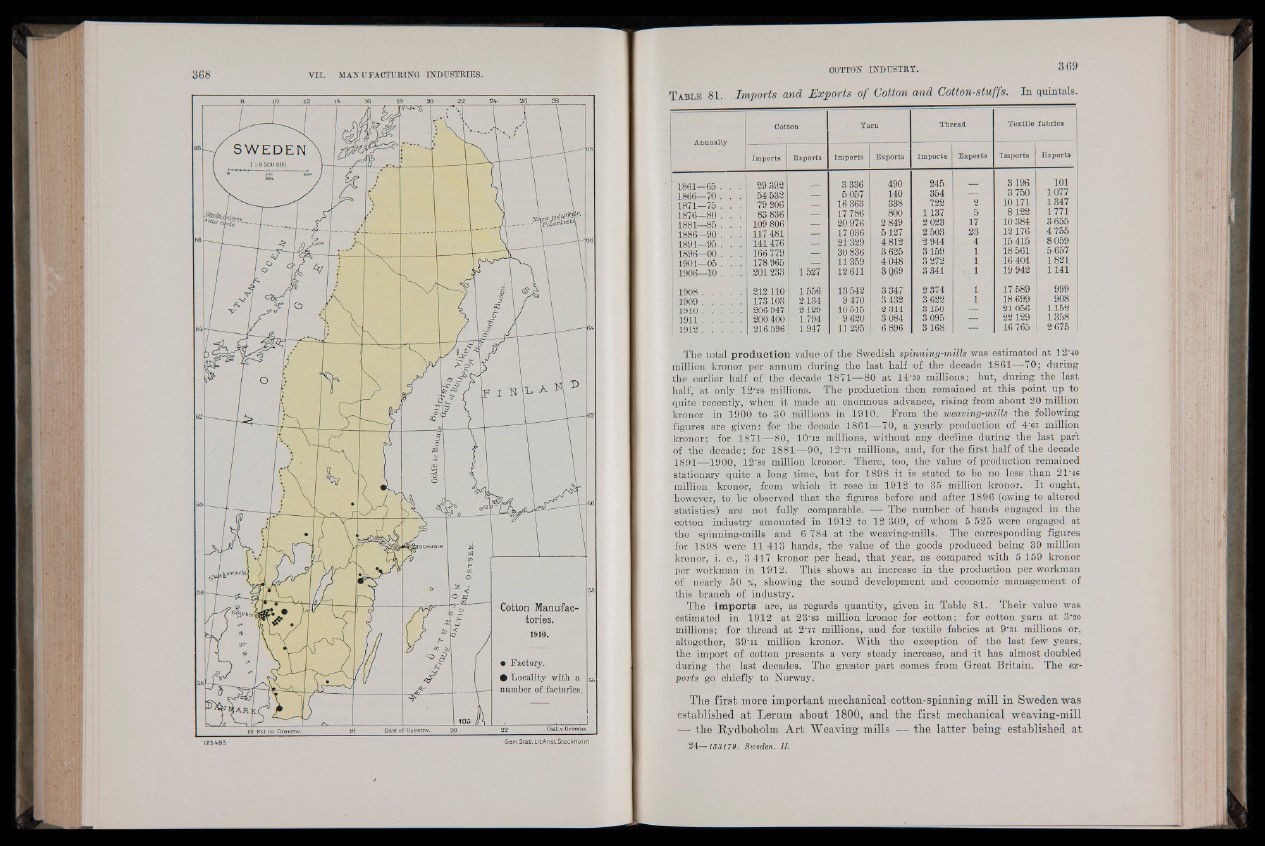
T able 81. Imports and Exports o f Cotton and Cotton-staff s. In quintals.
Annually
Cotton Tarn Thread Textile fabrics
Imports Exports Imports Exports Imports Exports Imports Exports
1 1861—65 . . . 29 392 3 336 490 245 _ 3196 101
1866—10 . . . 54 532 _ 5 057 140 354 .. — 3 750 1077
1871—75 . . . 19 206 _ 16 363 338 722 2 10171 1347
1876—80 . . . 83836 17 786 800 1137 5 8122 1771
1881—85 . . . 109 806 20 976 2 849 2023 17 10 384 3 655
1886—90 . . . -117 481 ._ 17036 5127. 2 503 23 12176 4755
1891—95 . . . 141476 -- 21329 4 812 2 944 4 15415 8059
1896—00 . . . 166779 --- 30 836 3 625 3159 1 18 561 5 657
1901—05 . . . 178 965 _ 11359 4048 3 272 1 16 404 1821
1906—10. . . 201233 1527 12 611 3 Q69 3 341 ;; - 1 19 942 1141
1908 ................ 212110 1556 13 542 3 347 2 374 1 17 589 999
1909 . . . . . 173103 2134 9 470 3 432 3 622 1 18 699 908
1910................ 206 947 2129 10 515 2 344 3150 gjailBlm 21056 1152
1911................ 200 400 1794 9 620 3 084 3 095 S£§||Sp?ïi 22129 1358
1912 . . . . . 216 596 1947 11 295 6 896 3168 16 765 2 675
The total p r o d u c tio n value of the Swedish spinning-mills was estimated at 12‘40
million kro&or per annum during the last half of the decade 1861— 10; during
the earlier half of the decade 1871M80 at 14‘ss millions; but, during the last
half, at only 12-28 millions. The production then remained at this point up to
quite recently, when it made an enormous advance, rising from about 20 million
kronor in 1900 to 30 millions in 1910.- From the weaving-mills the following
figures are given: for the decade 1861—10, a yearly production of 4'67 million
kronor; for 1871— 80, 10'12 millions, without any decline during the last, part
of the decade; for 1881— 90, H ; i millions, and, for the first half of the decade
1891—1900, 12-88 million kronor. There, too, the value of production remained
stationary quite a long time, but for 1898 it is stated to be no less than 2 1 ‘46
million kronor, from which it rose in 1912 to 35 million kronor. I t ought,
however, to be observed that the figures before and after 1896 (owing to altered
statistics) are not fully comparable.' — The number of hands engaged in the
cotton industry amounted in 1912 to 12 309, of whom 5 525 were engaged at
the _ spinning-mills and 6 184 at the'weaving-mills. The corresponding figures
for 1898 were 11 413 hands, the value of the goods produced being 39 million
kronor, i. e., ~3 417 kronor per head, that year, as compared with 5 159 kronor
per woikman in 1912. This shows an increase in the production per workman
of nearly 50 %, showing the sound development and economic management of
this branch of industry.
The im p o r ts are, as regards quantity, given in Table 81. Their value was
estimated in 1912 at 23'83 million kronor for cotton; for cotton yam at 3 '20
millions; for thread at 2"77 millions, and for textile fabrics at 9‘3i millions or,
altogether, 39'ii million kronor. With the exception of the last few years,
the import of cotton presents a very steady increase, and i t has almost doubled
during the last decades. The greater part comes from Great Britain. The exports
go chiefly to Norway.
The first more important mechanical cotton-spinning mill in Sweden was
established at Lerum about 1800, and the first mechanical weaving-mill
— the Rydboholm Art Weaving mills — the latter being established at